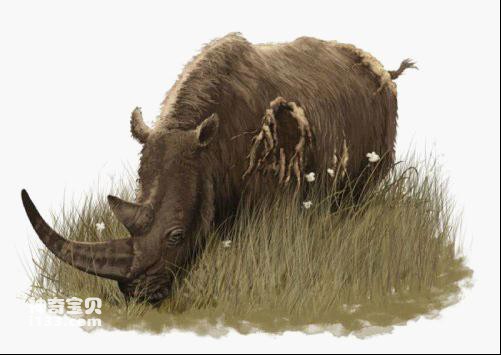The Tibetan Woolly Rhinoceros has the typical characteristics of the Woolly Rhinoceros: such as a slender skull, an ossified nasal septum, a broad and flat nasal horn base, a downwardly inclined nasal bone, an elevated and posteriorly extended occipital crest, a tall tooth crown, and well-developed Dental fossa etc.

Tibetan woolly rhinoceros recovery map
On the other hand, the Tibetan woolly rhinoceros is different from other advanced woolly rhinos in that its nasal septum is weakly ossified, accounting for only one-third of the length of the nasal notch; the mandibular symphysis is moved forward; the cheek teeth The chalky cover on the surface is sparse, and the outer ridge is slightly folded; the second upper molar has a weak middle cusp, and the third upper molar is triangular; the lower cheek teeth, the lower ridge is recurved and has a significantly curved rear end; , The anterior rib of the third lower molar is weak, etc.
The skull of the Tibetan woolly rhinoceros has a rather long face, and the rough surface occupies the entire back of the nasal bone, indicating that it had a huge nose horn when it was alive; a wide and low ridge on the frontal bone indicates that it had another Only smaller forehead. The nasal horn is larger than that of most living and extinct rhinoceroses, and similar to that of Elasmodon and Dicrodon, but narrower in morphology.
The weight of the Tibetan woolly rhinoceros is estimated to be up to 1.8 tons based on the size of its skull. The size of a mammal is critical in determining its metabolic profile, with insulation requirements per unit of body weight decreasing as body size increases. In herbivores, this means that the absolute size of the body is a critical factor in determining the dietary fiber/protein ratio that the animal can tolerate. Larger animals have proportionally lower protein requirements and are more able to tolerate it. A greater proportion of fiber. The Tibetan woolly rhinoceros is similar in size to the Nihewan woolly rhinoceros, but smaller than the late Pleistocene woolly rhinoceros, which reached greater body mass in colder climates.
The cheek teeth of some primitive rhinos have begun to gradually change with changes in the natural environment. By the late Pleistocene, the woolly rhino evolved into an animal that feeds entirely on herbaceous plants: the height of the molars increased, chalk developed, and the enamel of the tooth sockets increased. Thick, these are adaptive traits for rougher foods. The tips of the upper molars of the Tibetan woolly rhinoceros have been significantly worn into a round shape. They are neither as sharp as those of rhinos that feed on leaves, nor as blunt as those that feed solely on herbaceous plants, indicating that they feed on herbaceous plants. The food structure is mainly mixed with shrubs. These characteristics are similar to those of Nihewan woolly rhinoceros and Tologoi woolly rhinoceros.
The ability of the huge and forward-angled nose horns to scrape snow may be the most critical feature of the Tibetan woolly rhino's ability to adapt to the harsh winters of the Tibetan Plateau. This represents a unique evolutionary advantage of the woolly rhinoceros lineage. Such a simple but significant "innovation" was formed before the permanent ice cap in the Arctic began, and laid an important foundation for the successful prosperity of the woolly rhinoceros in the late Pleistocene ice age fauna.
animal tags:
We created this article in conjunction with AI technology, then made sure it was fact-checked and edited by a Animals Top editor.